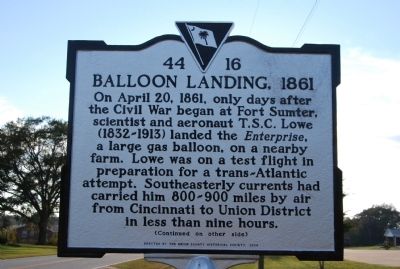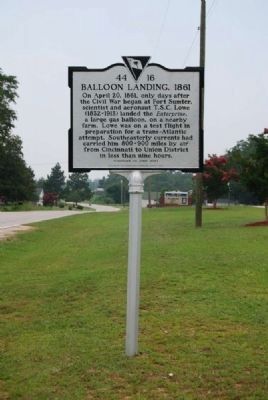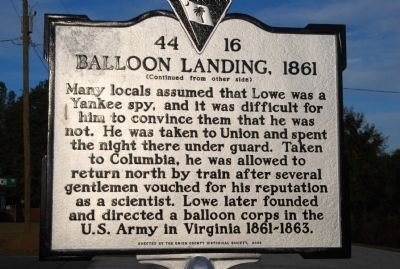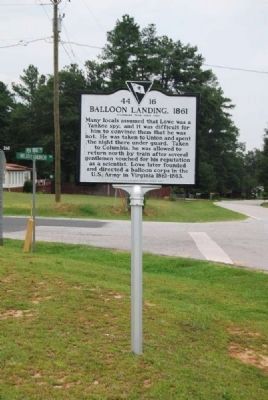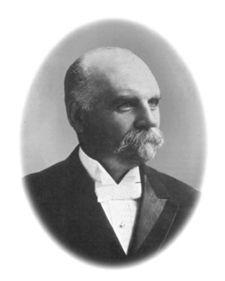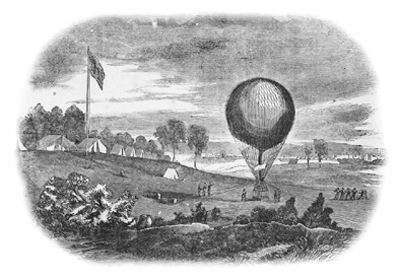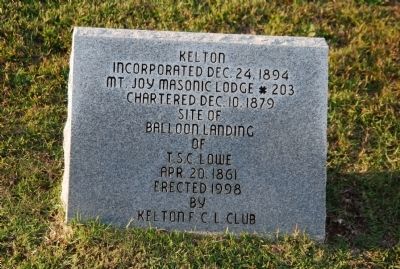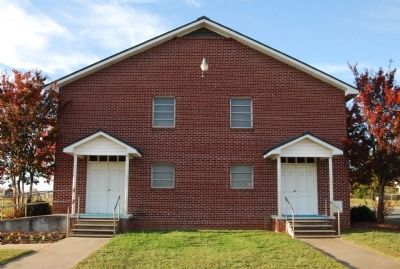Near Jonesville in Union County, South Carolina — The American South (South Atlantic)
Balloon Landing, 1861
[Front]:
On April 20, 1861, only days after the Civil War began at Fort Sumter, scientist and aeronaut T.S.C. Lowe (1832-1913) landed the Enterprise, a large gas balloon, on a nearby farm. Lowe was on a test flight in preparation for a trans-Atlantic attempt. Southeasterly currents had carried him 800-900 miles by air from Cincinnati to Union District in less than nine hours.
[Reverse]:
Many locals assumed that Lowe was a Yankee spy, and it was difficult for him to convince them that he was not. He was taken to Union and spent the night there under guard. Taken to Columbia, he was allowed to return north by train after several gentlemen vouched for his reputation as a scientist. Lowe later founded and directed a balloon corps in the U.S. Army in Virginia 1861-1863.
Erected 2009 by Union County Historical Society. (Marker Number 44-16.)
Topics and series. This historical marker is listed in these topic lists: Air & Space • War, US Civil. In addition, it is included in the South Carolina, Union County Historical Society series list. A significant historical date for this entry is April 20, 1861.
Location. 34° 50.025′ N, 81° 34.776′ W. Marker is near Jonesville, South Carolina, in Union County. Marker is at the intersection of Pea Ridge Highway (State Highway 44-13) and Mt. Joy Church Road (State Highway 44-260), on the left when traveling east on Pea Ridge Highway. Touch for map. Marker is in this post office area: Jonesville SC 29353, United States of America. Touch for directions.
Other nearby markers. At least 10 other markers are within 8 miles of this marker, measured as the crow flies. Kelton (a few steps from this marker); Professor Lowe Balloon Landing Site (about 500 feet away, measured in a direct line); Flat Rock Cemetery (approx. 2.1 miles away); Jonesville Confederate Monument (approx. 5.7 miles away); Fairforest Church (approx. 5.7 miles away); Jonesville Veterans Monument (approx. 5.7 miles away); Steen Family Cemetery (approx. 7 miles away); The Mill Village of Lockhart (approx. 7.4 miles away); From Industry to Artifact: Lockhart Mills (approx. 7.4 miles away); Furman L Fendley Highway (approx. 7.6 miles away). Touch for a list and map of all markers in Jonesville.
Also see . . .
1. Thaddeus S.C. Lowe. Thaddeus Sobieski Coulincourt Lowe (August 20, 1832 - January 16, 1913), also known as Professor T.S.C. Lowe, was an American Civil War aeronaut, scientist and inventor, mostly self-educated in the fields of chemistry, meteorology, and aeronautics, and the father of military aerial reconnaissance in the United States. (Submitted on October 31, 2009, by Michael Sean Nix of Spartanburg, South Carolina.)
2. Thaddeus Sobieski Constantine Lowe. Biographical site with numerous photographs. (Submitted on July 17, 2011, by Brian Scott of Anderson, South Carolina.)
3. Professor Thaddeus S.C. Lowe. Thaddeus Lowe was a self-educated man who was obliged to stop his formal schooling in the fourth grade. (Submitted on July 17, 2011, by Brian Scott of Anderson, South Carolina.)
4. Enterprise. The Enterprise was a gas inflated aerostat built by Prof. Thaddeus S.C. Lowe along with his father Clovis Lowe in 1858. (Submitted on July 17, 2011, by Brian Scott of Anderson, South Carolina.)
5. Union Army Balloon Corps. The Union Army Balloon Corps was a branch of the Union Army during the American Civil War, established by presidential appointee Thaddeus S.C. Lowe. (Submitted on July 17, 2011, by Brian Scott of Anderson, South Carolina.)
6. Off-course balloonist alarms South. This article, by John Lockwood, was published as a special to the Washington Times on Thursday, October 2, 2008 (Submitted on November 1, 2009, by Craig Swain of Leesburg, Virginia.)
Additional commentary.
1. The Enterprise
The Enterprise was a gas inflated aerostat built by Prof. Thaddeus S.C. Lowe along with his father Clovis in 1858. It was the second balloon built by Lowe at his Hoboken, N.J. facility and duly named with the express approval of his wife Leontine due to the amount of money and time they put into creating it. The Enterprise was built of the India silk, lightweight cording, and Lowe's patent (recipe kept secret) varnish which would keep the balloon envelope gassed up for up to two weeks.
Cincinnati to South Carolina
The Enterprise would become one in a set of smaller balloons taken to Cincinnati in March 1861 for use as a pre-flight test for a proposed transatlantic flight that would have taken place in June 1861. Lowe had already made a successful test flight in his super-gigantic balloon, the City of New York (renamed Great Western), in June 1860. His attempts to take off on a transatlantic trip in September were thwarted by weather which damaged the balloon to an extent it would have to be overhauled for the next late Spring. Prof. Joseph Henry of the Smithsonian Institution advised Lowe to take another test flight from a point west back to the eastern seaboard. This would maintain the interest in his investors. Thus the trip to Cincinnati.
Lowe can not be recognized as the discoverer of the Jet Stream, the high wind in the upper atmosphere that always blows to the east, since they are much higher than he could fly. He would use the normal easterly winds. It was his intent to wait for perfect conditions, that is, a wind blowing west through which he would fly and catch the easterly wind home. It was a month before the conditions came about. Lowe was hailed from a dinner being held in his honor to begin inflation. At 4 a.m. on April 19, 1861, Lowe boarded the Enterprise with a container of hot coffee wrapped in a blanket, another of water, and a batch of freshly printed Cincinnati newspapers which would be proof of his flight should he succeed.
Lowe ascended through the west wind and into the dark. By morning he was spotted over Kentucky. He had attained altitudes in excess of 20,000 feet according to his instrumentation, and had flown some 900 circuitous miles to a landing in Unionville, South Carolina. There he was taken under house arrest as a Yankee spy, and it was a few days deliberating his fate until which time a local college professor could vouch for Lowe's work as a scientist. Lowe was given safe passage back to Cincinnati to pick up his balloons. It was at this point that he realized he would have to offer his services to the Union Army in this time of emergency.
— Submitted October 31, 2009, by Michael Sean Nix of Spartanburg, South Carolina.
Credits. This page was last revised on June 16, 2016. It was originally submitted on October 31, 2009, by Michael Sean Nix of Spartanburg, South Carolina. This page has been viewed 2,270 times since then and 71 times this year. Photos: 1. submitted on October 31, 2009, by Michael Sean Nix of Spartanburg, South Carolina. 2. submitted on July 17, 2011, by Brian Scott of Anderson, South Carolina. 3. submitted on October 31, 2009, by Michael Sean Nix of Spartanburg, South Carolina. 4. submitted on July 17, 2011, by Brian Scott of Anderson, South Carolina. 5, 6, 7, 8. submitted on October 31, 2009, by Michael Sean Nix of Spartanburg, South Carolina. • Craig Swain was the editor who published this page.
